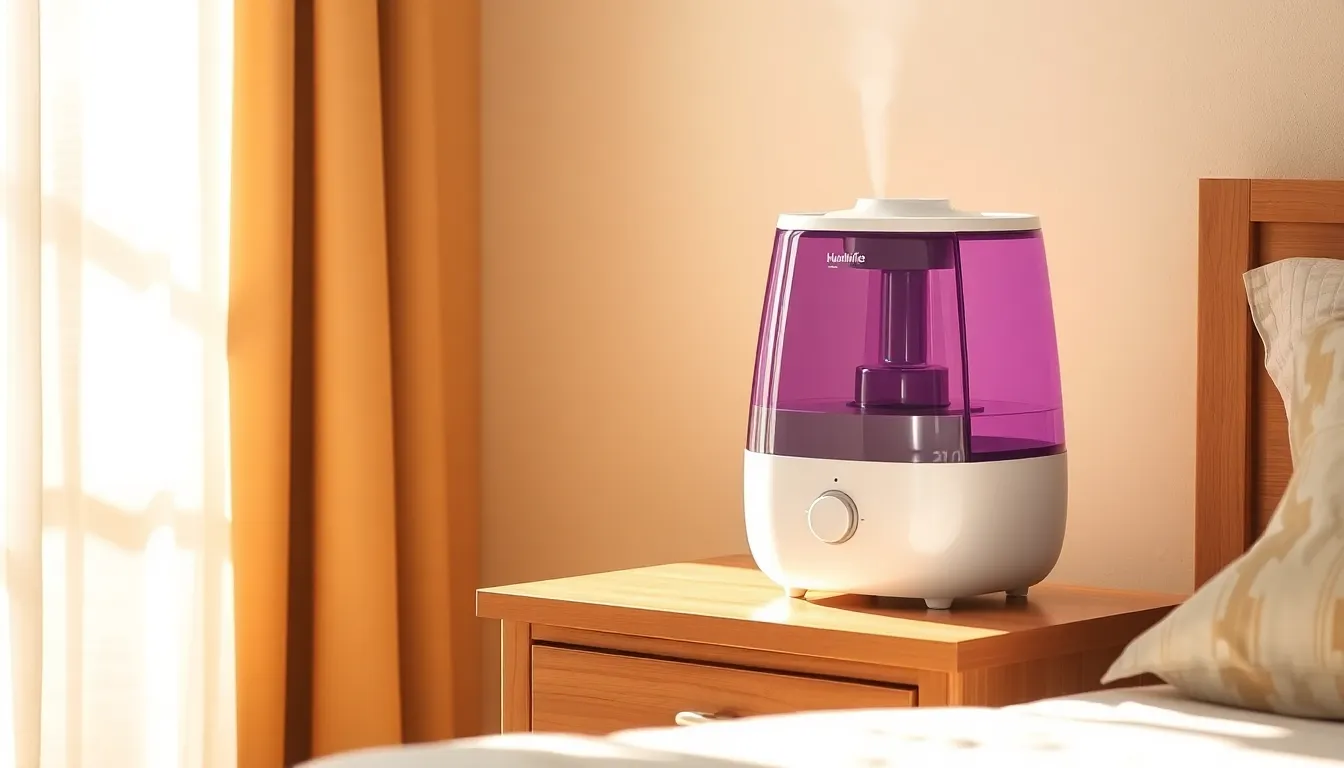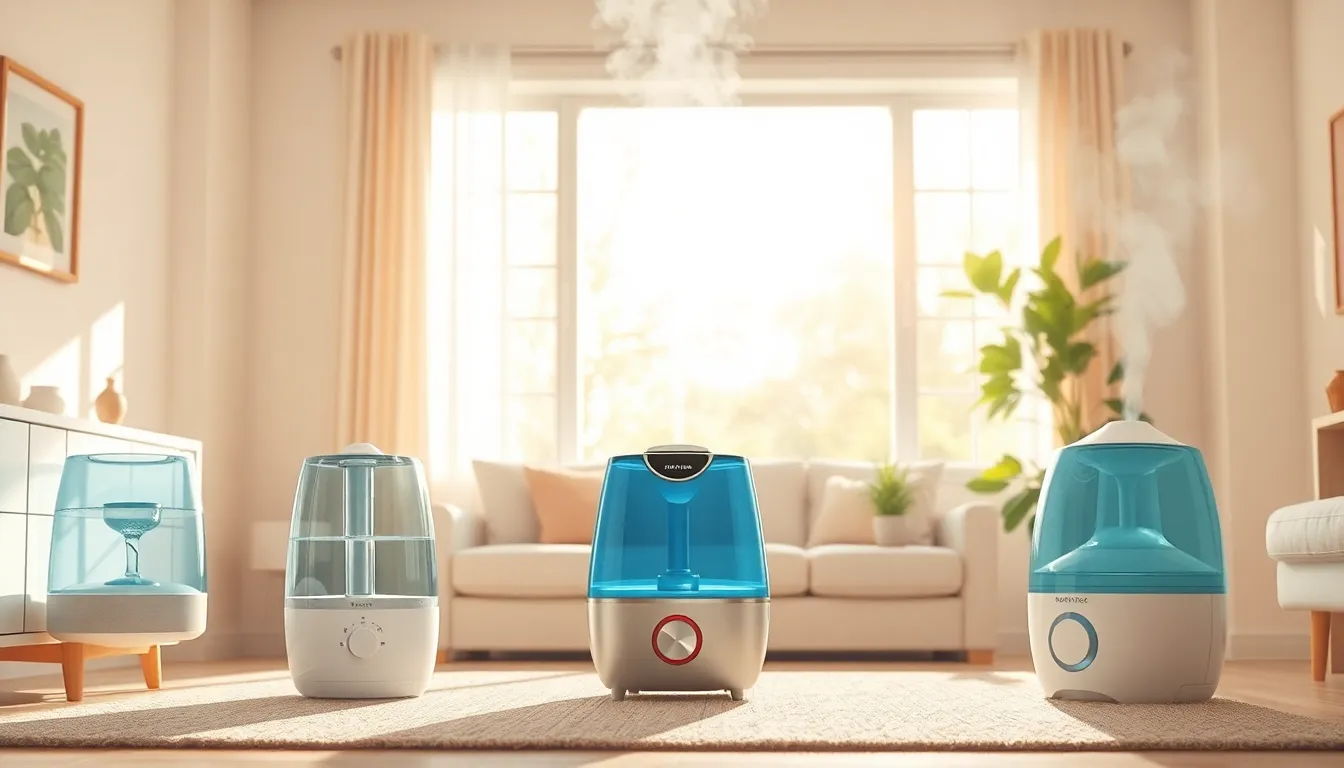When it comes to keeping the air in your home fresh and comfortable, humidifiers are like the unsung heroes of indoor living. They work tirelessly to add moisture to the air, making those dry winter months a little more bearable. But wait—what happens when these trusty devices start to resemble science experiments gone wrong? That’s right; without proper cleaning, a humidifier can quickly turn from a soothing oasis into a breeding ground for mold and bacteria.
Table of Contents
ToggleImportance of Humidifier Cleaning
Humidifier cleaning maintains the device’s efficiency and ensures healthy air quality. Neglected humidifiers can harbor mold and bacteria, which release harmful particles into the air. These microorganisms can cause respiratory issues, particularly in sensitive individuals, including children and the elderly.
Regular maintenance plays a crucial role in preventing contamination. Manufacturers recommend cleaning the humidifier at least once a week, depending on usage. Users can find cleaning schedules in the manuals provided with humidifiers. A clean humidifier effectively disperses moisture, improving overall comfort during dry seasons.
Health risks increase significantly with dirty humidifiers. Bacteria such as Legionella can thrive in stagnant water found in unclean units, leading to serious health complications. Mold spores can exacerbate asthma and allergy symptoms, making it essential to regularly inspect these devices.
Recognizing the signs of a dirty humidifier aids in mitigating health risks. Discoloration, strange odors, and mineral buildup indicate the need for immediate cleaning. Addressing these signs promptly prevents further degradation of air quality.
Additionally, maintenance extends the lifespan of the humidifier. Regular cleaning reduces the need for repairs and replacements, making it a cost-effective practice. Ensuring a clean humidifier contributes to long-term usage and effectiveness, maximizing investment.
Implementing proper cleaning techniques enhances the overall function of the humidifier. Using distilled water limits mineral deposits that can build up in the tank. Regularly replacing filters as per manufacturer recommendations helps maintain optimal performance.
Common Types of Humidifiers


Various types of humidifiers exist, each functioning differently to maintain moisture levels in indoor environments.
Evaporative Humidifiers
Evaporative humidifiers utilize a fan to draw air through a wet wick or filter. This process naturally evaporates water into the air, creating humidity. Regularly changing the wick is essential, as clogged or dirty filters can encourage mold growth. They perform well in moderate climates, providing a self-regulating mechanism since increased humidity limits evaporation. It’s advised to clean these units weekly to prevent bacterial contamination.
Ultrasonic Humidifiers
Ultrasonic humidifiers use high-frequency vibrations to produce a fine mist of water. This mist is then released into the air, significantly boosting humidity levels. Ensuring regular cleaning is vital, as mineral deposits can accumulate in the tank and emit white dust into the environment. They operate quietly, making them ideal for bedrooms or nurseries. Utilizing distilled water can reduce mineral buildup, enhancing efficiency and air quality.
Steam Vaporizers
Steam vaporizers boil water to create steam, releasing warm humidity into the air. This method can help in soothing respiratory issues, especially in cold weather. Cooling mechanisms cool the steam before it exits, preventing burns. It’s important to clean the tank frequently to avoid mineral buildup and bacterial growth. Using distilled water minimizes residue, enhancing the device’s performance and longevity. Regular maintenance ensures clean air and a healthier environment.
Steps for Humidifier Cleaning
Regular cleaning ensures humidifiers function properly, providing fresh air without health risks. Follow these steps for effective maintenance.
Daily Maintenance
Check the water level daily to prevent mineral buildup. Empty the tank every evening, rinsing it with clean water. Wipe the exterior surfaces with a damp cloth to remove dust and debris. Inspect the filter for any signs of wear, ensuring it remains in good condition. Refill the tank with distilled water rather than tap water, reducing the chances of mineral deposits.
Deep Cleaning
Schedule deep cleaning at least once a week for optimal performance. Start by unplugging the humidifier and disassembling removable parts. Use a mixture of white vinegar and water to soak these components for at least 30 minutes, which helps break down scale and impurities. Scrub any stubborn areas with a soft brush, ensuring no residues remain. Rinse thoroughly with clean water to eliminate vinegar. Allow all parts to dry completely before reassembling the unit.
Best Cleaning Solutions and Methods
Using proper cleaning solutions and methods keeps humidifiers functioning effectively. Vinegar offers a powerful solution for breaking down mineral deposits. Combine one part vinegar with one part water, and soak the removable parts to loosen buildup.
Bleach also serves as an effective disinfectant for deeper cleaning. Dilute one teaspoon of bleach in one gallon of water. After soaking, thoroughly rinse all parts with clean water to prevent bleach residue from lingering.
Commercial humidifier cleaners are widely available and can simplify the cleaning process. Select products specifically designed for humidifiers to avoid harsh chemicals that may damage components.
Utilizing distilled water instead of tap water prevents mineral deposits from forming. Regularly replacing filters enhances efficiency and cleanliness.
Wiping interior and exterior surfaces with a soft cloth helps remove dust and ensure optimal performance. Recommendations include using a microfiber cloth for cleaning surfaces to prevent scratches.
Checking and cleaning components on a weekly basis maintains air quality. Emptying the water tank daily prevents stagnant water, which can harbor bacteria.
Establishing a regular cleaning schedule promotes long-term appliance health. Follow manufacturer guidelines for specific cleaning procedures and maintenance for each humidifier type.
Tips for Maintaining a Clean Humidifier
To maintain a clean humidifier, follow these straightforward steps. Establish a weekly cleaning routine to prevent bacteria and mold buildup. Empty the water tank every day, as stagnant water invites contamination.
Use a vinegar and water solution for regular cleaning. Mix one cup of white vinegar with a gallon of water. This solution effectively breaks down mineral deposits and prevents scale formation. For deeper cleaning, a diluted bleach solution can help eliminate stubborn bacteria. Ensure a thorough rinse afterward to remove any bleach residue, which may affect indoor air quality.
Check the manufacturer’s guidelines for specific cleaning instructions. Some models may require unique care, so tailored steps maximize performance. Swapping out the filters regularly is essential, as filters play a significant role in ensuring clean air output.
When cleaning the exterior, use a soft cloth to avoid scratching surfaces. Dust buildup can compromise efficiency, so gentle wiping regularly removes dust and debris.
Consider using distilled water in the humidifier. Distilled water limits mineral deposits and keeps components functioning smoothly. Opting for commercial humidifier cleaners can also be beneficial; select products designed specifically for use in humidifiers.
Set reminders for scheduled maintenance to keep cleaning consistent. By sticking to a cleaning schedule, the humidifier performs optimally and contributes to a healthier environment. Regular cleaning efforts enhance longevity, making maintenance a worthwhile investment.



